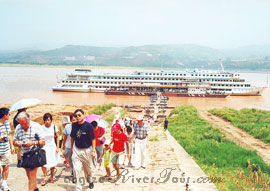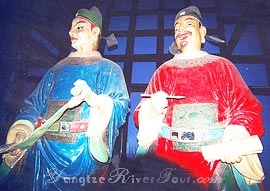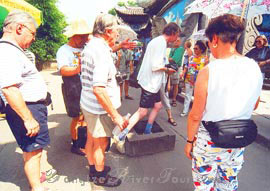 Fengdu lies in the southeast of the Sichuan Basin, covering an area of about 2,910 square kilometers (716,853 acres). Mountains take up about three fifths of the total area, which features a mild climate with distinct four seasons. Two thousand years ago, the area was under the subjection of the Ba Kingdom and was made its capital. The name 'Fengdu' was given in the Sui Dynasty (581-618).
Fengdu lies in the southeast of the Sichuan Basin, covering an area of about 2,910 square kilometers (716,853 acres). Mountains take up about three fifths of the total area, which features a mild climate with distinct four seasons. Two thousand years ago, the area was under the subjection of the Ba Kingdom and was made its capital. The name 'Fengdu' was given in the Sui Dynasty (581-618).Being 176 kilometers (117 miles) from the Center of Chongqing Municipality , Fengdu County is a famous tourism destination, well known for its distinct ghost culture. Ghost City in the Ming Mountain is actually a man-created Hades telling the story of people after death. A vivid portrayal of Hades has appeared in many classic works such as Journey to the West and Ghost Stories.
More than 1,000 emigrants have moved out of here because of the Three Gorges reservoir. After the completion of the Three Gorges Project , Fengdu will attract an increasing number of visitors.
Ghost City
The first stop of the Yangzte Cruise down-river from Chongqing is the Ghost City in the County of Fengdu. It is said that the Ghost City is where people checked in after their death. Anyone who wants to experience an atmosphere that awakens thoughts about the prospect of life after death should not miss it, as they will not be disappointed.
 The Ghost City is situated on the well-known Ming Mountain in the northeast of the Fengdu County. With an altitude of about 287 meters (942 feet) covering an area of 450 square meters (0.1 acre), the Ming Mountain was regarded as one of the Blessed Fields of the Taoism and it is endowed with more than 27 ancient temples.
The Ghost City is situated on the well-known Ming Mountain in the northeast of the Fengdu County. With an altitude of about 287 meters (942 feet) covering an area of 450 square meters (0.1 acre), the Ming Mountain was regarded as one of the Blessed Fields of the Taoism and it is endowed with more than 27 ancient temples.
A legend has it that two Taoists, Yin Changsheng and Wang Fangping, of the Han Dynasty (206 BC-220 AD) developed themselves spiritually on the mountain and thus became celestial beings, which is why Taoists since have favored this site. When it came to the Tang Dynasty (618-970), the surnames of the two were added together as Yin Wang (King of Hades), which gradually changed to the Ghost City (Nether World). Consequently, a complete set of buildings, including temples, halls, bridges, platforms, as well as the gates of hell, were constructed reflecting the scenes that people had imagined. Trials are enacted in the well-equipped courtroom, and those who violated the law and committed crimes before their death are punished.
 Various terraces and towers have been erected amongst the gloomy trees and plants. Many statues of ghosts and monsters bearing ferocious expressions and exaggerated poses are set in and around the buildings. Inscriptions of some celebrities such as Su Shi (a poet in the North Song Dynasty), Lu You (a poet in the South Song Dynasty) can also be found here. Whilst the whole experience reflects an aspect of Chinese culture visitors should bear in mind that the Ghost City represents much more than a simple superstition.
Various terraces and towers have been erected amongst the gloomy trees and plants. Many statues of ghosts and monsters bearing ferocious expressions and exaggerated poses are set in and around the buildings. Inscriptions of some celebrities such as Su Shi (a poet in the North Song Dynasty), Lu You (a poet in the South Song Dynasty) can also be found here. Whilst the whole experience reflects an aspect of Chinese culture visitors should bear in mind that the Ghost City represents much more than a simple superstition.
Each year the Temple Fair is held on 3rd March under the lunar calendar and is strikingly attractive. Processions highlighting the ghosts and shades are performed successively allowing visitors to enjoy 2,000 years of history. It is no wonder then that the county of Fengdu, blessed with such a distinct culture is now attracting increasing numbers of visitors every year.
| Admission Fee: | CNY 60(Excluding 20 for cable car) |
| Opening Hours: | 09:10 to 17:00 |

